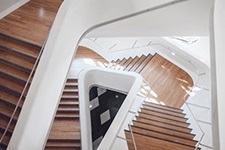What does the workspace of the future look like? The future of work is about flexibility, technology and the employee experience. These trends are driving companies to reshape the work environment and better align office design with their brand and culture. Workspace modernization also provides a unique opportunity to infuse health and well-being into the daily employee experience and elevate its role in your workforce strategy.
1. Bring the Outdoors In

Air quality and lighting can significantly impact employee well-being and productivity. On average, Americans spend approximately 90% of their time indoors, where concentrations of some pollutants are two to five times higher than outdoors and improper lighting disrupts the circadian rhythm. Forwarding-thinking organizations are embracing biophilic design with natural and circadian lighting, natural ventilation, views of nature and plant life from green walls and potted plants to corporate gardens and outdoor workspaces.
2. Design with Movement in Mind

You’ve heard sitting is the new smoking. Research links sedentary behavior with heart disease, Type 2 diabetes, cancer and other health conditions, and globally, six percent of deaths are attributed to physical inactivity. The office of the future embraces a flexible design where employees choose where and how they work—this requires movement throughout the day to open spaces, private offices, different-sized meeting rooms, phone booths, lounges, fitness centers, game rooms, designated meditation spaces, cafes and other common areas. Another prominent design feature that encourages movement and is making a comeback is a stunning, centrally located staircase.
3. Don't Let Noise Wreck your Workday

Complaints of a noisy office are often dismissed too quickly. According to the Workforce Health Organization, noise is an underestimated threat that can cause health problems and hinder work performance. Companies can address noise through carpeting, furniture and ceilings designed to absorb sound, sound masking systems, dedicated areas for high noise and quiet retreats, and when in doubt, giving employees noise-canceling headsets.
4. Sensors Everywhere: Creepy or Cool?

Reserving your desk may be a thing of the past when sensors monitor workstation usage and availability. Capturing real-time data helps employers optimize space utilization and improve the employee experience, but tracking employee behavior has the potential to give off an anxiety-inducing Big Brother vibe. Transparency and communication are critical, especially when sensors are involved. Make sure employees understand sensors will be used to identify overall trends and remove obstacles to their benefit, not surveil individual workers.
5. Create a Culture & Community

As employers reimagine their workspaces, a key component of well-being is at the forefront: social connectedness. According to the Business Group on Health/Optum Workplace Well-being and the Employee Experience Survey report, support for social health at work is relatively low, and only 34% of workplace design supports socialization. A brilliantly designed space that matches the employer brand and includes areas for social interaction can create a genuine sense of belonging among your employees.
